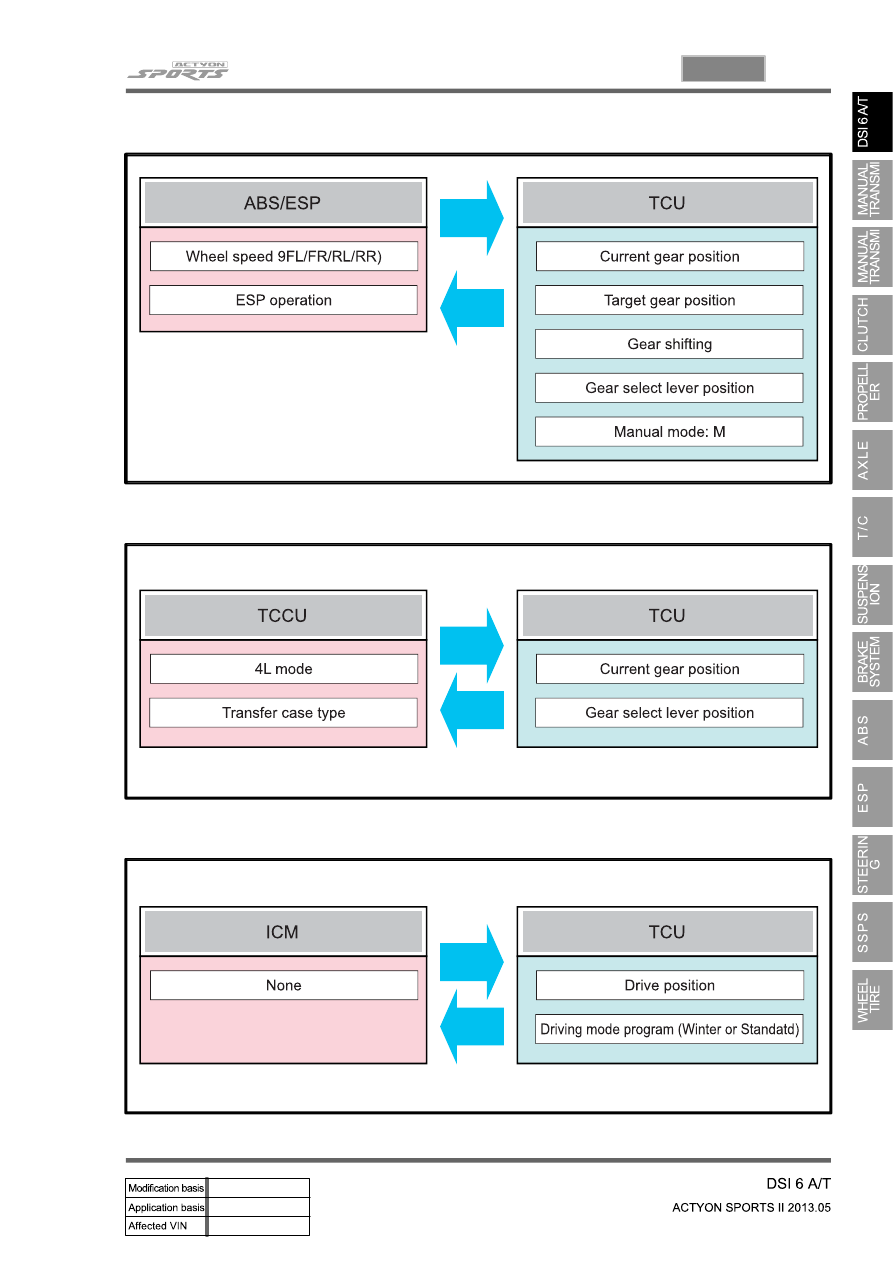SsangYong Actyon Sports II. Manual — part 117

01-19
3680-01
CAN Input/Output Data between ABS/ESP and TCU
▶
CAN Input/Output Data between TCCU and TCU
▶
CAN Input/Output Data between ICM and TCU
▶
01-20
3) Transmission Control Monitoring System
TCU monitors all input and output signals to identify possible failures. If a fault is detected, TCU activates
the safety mode to keep the driver’s safety and the life span of transmission.
Monitoring the Supply Voltage
▶
Monitoring the Supply Voltage to Solenoid
▶
Monitoring the Gear Ratio
▶
Monitoring the Torque Converter
▶
If the battery voltage is too high or too low, the TCU sets the DTC.
TCU monitors the circuits for open or short to ground or supply. The monitoring function evaluates the
voltage characteristics while the switch is ON.
TCU monitors the gear is engaged properly in the allowed time.
TCU checks if the torque converter can be locked up properly. If it is failed, TCU releases the torque
converter clutch to activate the fail-safe operation.
4) Shift Energy Management
This function involves reducing or increasing the engine output torque during shifting. This reduces the
energy which is dissipated in the friction elements of the transmission during up-shift. This is done by
reducing the engine torque during the gear ratio change without interrupting the tractive drive.
This function is used for:
Increasing the life span of transmission by shortening the slipping time
Improving the shift comfort by reducing the step changes due to gearshift
Transferring a higher engine power
-
-
-
Real-time control of engine torque is required to maintain the proper shift operations and the durability of
transmission. TCU controls the engine torque during the gearshift by synchronizing the operation of
transmission clutches.
01-21
3680-01
Pressure Modulation
▶
To provide a higher level of shift comfort and durability, the hydraulic pressure in the shift related friction
elements of the transmission must be matched accurately to the input torque to transmission. This
hydraulic pressure is composed of a hydraulically pre-set basic pressure and a control pressure which is
set by one of the variable bleed solenoids.
The transmission input torque can be directly calculated from the following operating parameters:
engine torque signals
engine speed or any signal transmitted from ECU through CAN lines
converter slip
-
-
-
Separate pressure characteristics for each gear change make it possible to adapt precisely to the
particular shift operation.
5) Shift Mode Selection by TCU
The driver can select Standard (S) or Winter mode (W) with the mode switch. TCU automatically
changes the shift mode according to the transmission oil temperature, uphill or downhill gradient, and
altitude to keep the good driving conditions.
Standard Mode (S)
▶
Uphii and Downhill Mode
▶
Altitude Mode
▶
Standard Mode is selected when setting the mode switch in Standard (S) position with the gear select
lever in “D” and the transmission oil temperature in normal operating range. Proper shift timing
provides the optimized fuel economy and good driving conditions.
In this mode, the operating points of torque converter lock-up clutch and the shifting points are adjusted
according to the vehicle weight.
In this mode, the shifting points are automatically adjusted according to the altitude to compensate the
engine torque changes due to barometric pressure and temperature.
01-22
Winter Mode (W)
▶
Low Range Driving Mode
▶
Warm Up Mode
▶
When the Winter mode is selected, the second gear is engaged to start off the vehicle easily to prevent
wheel spin on slippery surfaces and WINTER mode indicator comes ON. The first gear is not available
in this mode.
When the vehicle is in 4L driving mode, the transmission uses a different shift mode to optimize the low
range driving. Similar to Winter mode, the first gear is not available.
This mode is normally used when the transmission oil temperature is below 20°C.
The torque converter cannot be locked-up below 20°C to provide the warming up process of
transmission.
Hot Mode
▶
If the transmission oil temperature is between 110°C and 145°C, the system provides the cooling
and reduces the load to the transmission. This is called Hot Mode.
Above 110°C:
Above 130°C:
Above 145°C:
-
-
-
In Hot Mode, any of shift mode is not available.
Cruise Control
▶
When the cruise control is activated, the engine ECU requests the downshift to increase the engine
brake effect.
PWM fan ON
the engine torque is reduced and WINTER indicator is blinking
the transmission is held in Neutral (N) gear until the oil temperature falls below
120°C (Final protection)

Нет комментариевНе стесняйтесь поделиться с нами вашим ценным мнением.
Текст